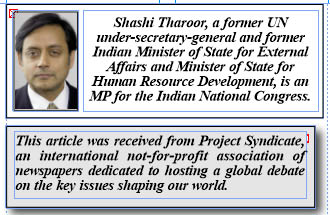By Shashi Tharoor
NEW DELHI – A flurry of assaults on freedom of the press in recent months has raised troubling questions about the state of India’s democracy under Prime Minister Narendra Modi. India has long had a free and often raucous press. But the situation has changed dramatically since Modi’s government came to power in 2014.
In late January, police filed criminal charges – including sedition, which carries a life sentence – against eight journalists who covered a protest in Delhi that turned violent. Their crime: reporting the claims of a dead protester’s family that he had been shot and killed by the police. I face the same charges for having tweeted their claim when it was reported.
Six journalists and I (a Congress party MP) are accused of “misreporting” facts surrounding the death. We face charges in four states ruled by Modi’s Bharatiya Janata Party (BJP). The publisher, editor, and executive editor of the investigative news magazine The Caravan face ten sedition cases in five states for reporting the story, and the magazine’s Twitter account was briefly suspended by government order.
Ours is hardly an isolated case. In 2020 alone, 67 journalists were arrested, while nearly 200 were physically attacked in the 2014-19 period, including 36 in 2019, according to a study by the Free Speech Collective. A journalist arrested on his way to report on the aftermath of a gang rape in Uttar Pradesh state has been in jail for six months, being allowed out briefly only to visit his ailing mother in Kerala state, more than two thousand kilometers (1,243 miles) away.
Conversely, reporting that is sympathetic to the government proceeds unchecked, even if it is inaccurate, propagandistic, or inflammatory, particularly in retailing bigotry against minorities or discrediting the political opposition. The mainstream media, whether print or television, has been cajoled and cudgeled into cheerleading for Modi’s government.
Once dominated by government programming, India’s visual media landscape is now brimming with numerous private offerings, with over a hundred 24-hour television news channels today in multiple languages. My state of Kerala alone has 13 all-news channels in the regional language, Malayalam.
But competition has fueled a race for eyeballs and advertising revenue that has steadily eroded the quality of Indian journalism. Whereas the Fourth Estate once placed a premium on editorial standards and journalistic ethics, it has morphed into a grotesque platform driven by sensationalism and vilification. The news must be broken – and so, it seems, must the newsmaker. The government and its stalwarts are almost never the targets: the opposition, civil society, and dissenting individuals are.
As more Indians enjoy the fruits of literacy and the increasing affordability of smartphones and reduced data costs, India has witnessed a boom in print circulation as well as in social media as a news source, especially among young people. But newspapers are also conscious that they must compete in a tight media environment, where TV and digital media set the pace. They know that every morning they must reach readers who have watched TV and read WhatsApp already. So, newspapers feel the need to “break” news in order to outdo their TV and social media competitors.
The result is that India’s media, in its rush to run a story, has fallen prey to predictable hazards, often becoming a willing accomplice of the motivated leak and the malicious allegation, trading integrity for access to well-placed government sources. In this environment, the BJP has undermined the free press through co-optation and intimidation, thus ensuring that much of the press produces only news that is sympathetic to the causes the ruling party holds dear, or that distracts the public’s attention from government failings.
India’s news media ought to be holding the government accountable, not kowtowing to it. The good news is that not everyone has forgotten the watchdog responsibility that free media must exercise in a democracy. The Editors Guild of India has asked Modi to revoke the Information Technology (Intermediary Guidelines and Digital Media Ethics Code) Rules, 2021, arguing that the new rules undermine press freedom.
The bad news is that such developments are a major reason for the recent decisions of democracy watchdogs Freedom House (which downgraded India from “free” to “partly free”) and the V-Dem Institute (which now calls India an “electoral autocracy”) to express alarm about the health of the country’s democracy. “India, the world’s most populous democracy, is also sending signals that holding the government accountable is not part of the press’s responsibility,” wrote Freedom House.
The Modi government’s weapon of choice is the colonial-era sedition law: an overwhelming majority of sedition cases have been filed in the seven years since Modi and his BJP came to power, according to data compiled by the website article14. In a criminal justice system that has changed little since the colonial era, detentions, charges, police investigations, and trials ensure that even if actual convictions are rare, the process itself is the punishment.
Freedom of the press is ultimately the best guarantee of liberty and progress. It is the mortar that binds together a free society – and it is also the open window that, in Mahatma Gandhi’s famous metaphor, allows the winds of the world to blow freely through the house. If Modi’s efforts to de-institutionalize what used to be a dynamic and independent Fourth Estate persists, public confidence in the media will steadily decline, along with confidence in Indian democracy.
Copyright: Project Syndicate, 2021.










